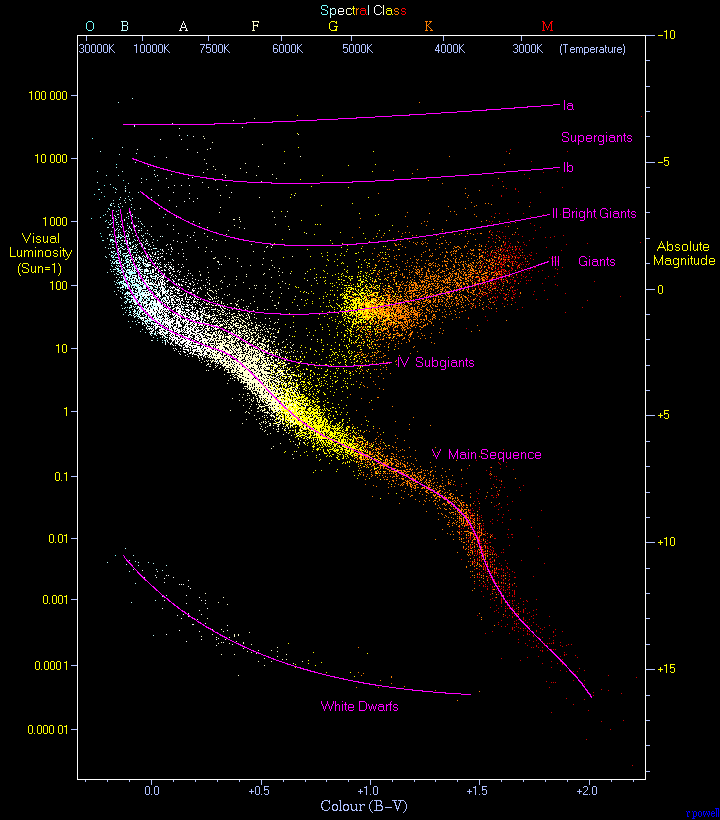The Hertzsprung Russell Diagram
The most famous diagram in astronomy is the Hertzsprung-Russell diagram. This diagram
is a plot of luminosity (absolute magnitude) against the colour of the stars ranging
from the high-temperature blue-white stars on the left side of the diagram to the
low temperature red stars on the right side.
This diagram below is a plot of 22000 stars from the Hipparcos Catalogue together with
1000 low-luminosity stars (red and white dwarfs) from the Gliese Catalogue of Nearby
Stars. The ordinary hydrogen-burning dwarf stars like the Sun are found in a band
running from top-left to bottom-right called the Main Sequence. Giant stars form
their own clump on the upper-right side of the diagram. Above them lie the much rarer
bright giants and supergiants. At the lower-left is the band of white dwarfs - these
are the dead cores of old stars which have no internal energy source and over billions
of years slowly cool down towards the bottom-right of the diagram.
The Luminosity Classes of Stars
Stars are classified into five main luminosity classes. These are the five classes:
- I Supergiants
- Very massive and luminous stars near the end of their lives. They are
subclassified as Ia or Ib, with Ia representing the brightest of these stars.
These stars are very rare - 1 in a million stars is a supergiant. The nearest
supergiant star is Canopus (F0Ib) 310 light years away. Some other examples are
Betelgeuse (M2Ib), Antares (M1Ib) and Rigel (B8Ia).
- II Bright Giants
- Stars which have a luminosity between the giant and supergiant stars. Some
examples are Sargas (F1II) and Alphard (K3II).
- III Normal Giants
- These are mainly low-mass stars at the end of their lives that have swelled
to become a giant star. This category also includes some high mass stars
evolving on their way to supergiant status. Some examples are Arcturus (K2III),
Hadar (B1III) and Aldebaran (K5III).
- IV Subgiants
- Stars which have begun evolving to giant or supergiant status. Some examples
are Alnair (B7IV) and Muphrid (G0IV). Note also Procyon which is entering
this category and therefore is: F5IV-V.
- V Dwarfs
- All normal hydrogen-burning stars. Stars spend most of their lives in this
category before evolving up the scale. Class O and B stars in this category are
actually very bright and luminous and generally brighter than most Giant stars.
Some examples are the Sun (G2V), Sirius (A1V), and Vega (A0V).

